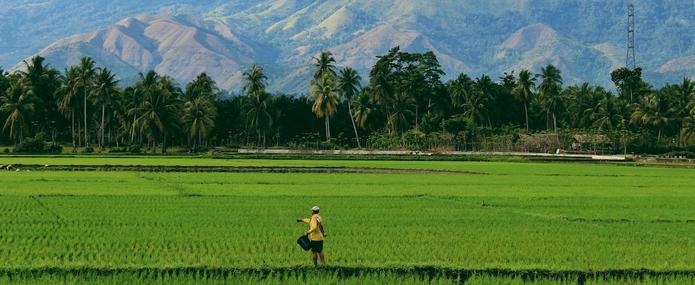The observation of a drift in methane (CH4) emissions raises questions: while it is the second most important greenhouse gas (GHG) in terms of its impact on the climate and its atmospheric concentration is constantly increasing,1 the metrics used to measure it and take it into account in policies to combat climate change appear to be out of step with the objectives of the Paris Climate Agreement. Looking at methane in terms of its impact on global warming by the end of the century highlights mitigation opportunities that represent climate-smart responses to developing countries' ambition in strategic sectors (agriculture, energy, waste management).
Read the associated internship report [in French]
Methane, a greenhouse gas forgotten in the fight against climate change?
For the last 10 years, each year, 10 Mt of methane2 have been emitted more than the chemical reactions in the atmosphere can degrade, and the atmospheric concentration of this pollutant has increased,3 placing it on a warming trajectory at 4°C. It is therefore urgent to respond to the challenge of these emissions, which are responsible for about 20% of global warming.
While methane has a greater capacity to heat the planet than CO2, its lifetime in the atmosphere is short (about 12 years). To take this into account, the choice was made in 19954 to use global warming power (GWP) and equivalent ton of CO2 (teqCO2), metrics that allow to compare the impact of a GHG on climate relative to CO2. The most recent IPCC report5 concludes that one tonne of methane emitted will have had as much effect on the climate as 86 tCO2 after 20 years, but this value drops to 33 after 100 years.
To understand the impact of methane on the emission trajectory (and ultimately on the warming curve by the end of the century), the isolated presentation of data calculated with a 100-year GWP (at the expense of a 20- or 50-year analysis, or even emission "ranges") seems inappropriate and leads to underestimating the impact of GHG mitigation policies.
Methane and low-carbon development trajectories
The more we reason over short-time horizons, the more responsibility attributable to methane-emitting activities increases; the closer the deadline approaches, the more relevant it is to highlight mitigation measures specifically targeting this GHG. For countries such as Colombia or Viet Nam, where agriculture (livestock, rice) is a pillar of the economy, the shift to a shorter-term horizon puts methane at the forefront of the emissions inventory.
Recognising the importance of methane highlights mitigation levers in areas where there is little experience in seeking climate compatible trajectories. The reflection on methane then makes it possible to consider strategies that are at least as relevant for the development ambitions of countries: food security, improvement of sanitary conditions, etc. It is therefore an opportunity for developing countries and donors to cooperate.
The issue of agricultural methane in low-carbon development trajectories
Agriculture concentrates most of the methane emissions and abatement margins, but the development of climate-smart development trajectories is complex. There are two main sources of emissions: rice cultivation (10% of total anthropogenic emissions) and livestock farming (30%, associated with both digestion/enteric fermentation and animal excreta). For rice cultivation, the practice of alternating irrigation (integrated into more intensive rice systems) now affects millions of farmers and considerably reduces methane emissions: its adoption is particularly documented in West Africa and Tamil Nadu, but also in South-West Asia, where it has led to an increase in yields and a decrease in the carbon intensity of production.
For breeding, two avenues are being explored. Intensified production reduces the level of "unproductive" emissions (control of animal life, birth control, etc.) and therefore the level of methane emissions/kg of milk or meat produced—with, however, a trade-off potential for livestock feed sources, which can lead to significant N2O emissions. The methanisation of animal manure (i.e. its transformation into biogas) also makes it possible to considerably reduce the emissions associated with its management. Methanisation is now a great success in some African countries while providing carbon-free energy to sedentary pastoralists who are committed to it.
Methane and energy: a crucial issue for developing countries
In the energy sector, the consideration of fugitive emissions along the natural gas value chain questions its place as a fuel in the energy transition. Above a certain percentage of leaks, the climate benefits of using natural gas in comparison to coal should be put into perspective. Even if unfavourable gas situations are in the minority, this observation raises questions about the place to be given to gas in local coal phase-out strategies, depending on local situations. Conversely, controlling emissions along the value chain is a powerful and cost-effective way to mitigate emissions from the sector in developing countries in Asia and the Middle East where the International Energy Agency (IEA) has shown that the costs of such measures are lower.
The case of waste
The waste sector (solids and wastewater) concentrates many low-cost mitigation opportunities that will require the emergence of high-tech systems (flaring, turbining), which is difficult in geographies where waste culture is not the norm. The existence of rationalised collection systems is an essential prerequisite for biogas recovery, as is the implementation of proactive policies and regulatory frameworks allowing the development of sustainable sectors.
Depending on the country, it will therefore be more a question of developing avoidance policies: sorting, recycling or composting make it possible to remove part of the organic matter that causes emissions. These practices often involve local populations and generate additional benefits (hygiene, living and working conditions, environment, etc.).
In this sector as elsewhere, the comparison of costs with the benefits of methane mitigation is not always sufficient to make projects profitable, but the situation evolves when a frame of reference is envisaged where one considers the co-benefits generated and the intrinsic value of methane.

